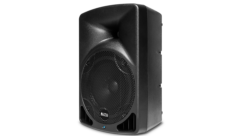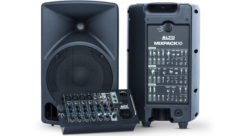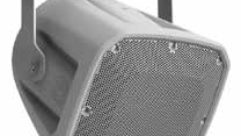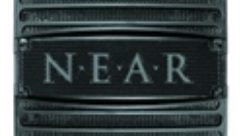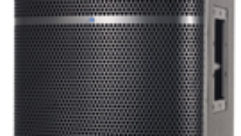
Technology Showcase:
Molded Loudspeakers
Jan 1, 2006 12:00 PM,
By Bruce Borgerson
Made to move or install, or both.
Galaxy CORE PASX140
Mr. McGuire: I just want to say one word to you — just one word. Are you listening?
Ben: Yes, I am.
Mr. McGuire: Plastics. Think about it.
Back in 1967, when Dustin Hoffman’s character in The Graduate puzzled over this unsolicited advice, nearly all loudspeaker enclosures were made from wood. Today, plastic cabinets are ubiquitous. Regarding loudspeakers, Mr. McGuire was prophetic: Plastics were the wave of the future.
The percentage of professional loudspeakers available with molded cabinets increases year by year, and the “plastic” varieties now dominate several market segments. This survey will look at two of these categories: all-in-one portable units and “dual-use” models that can be used either as portables or for permanent or semi-permanent main PA installations.
Although molded cabinets dominate these product categories to the virtual exclusion of wood, the processes and materials involved in molding technology are not covered in detail here. This deliberate omission is for two reasons: First, although the specific material is noted in many listings below, in most instances it is not a crucial factor. (The internal details of cabinet design are another matter, but this is more difficult to evaluate and summarize in a few words.) Also, space limitations preclude treating the subject at meaningful length. However, for readers who are curious about molding technology, an article on the subject can be found at www.svconline.com.

Califone PA 916
ROLL WITH ‘EM
Portable molded cabinet systems are familiar territory to Anchor Audio, as these units comprise the bread and butter of the company’s product line. The Anchor range tops out with the Beacon (base price $2,718), a fold-out line array the company claims can cover a crowd of 5,000. At the other extreme, the lightweight (8.5lbs.) Portacom is suitable for meeting rooms and classrooms (base price $190). In the middle of the line is the versatile Explorer Pro, a 23lb. unit with a 10in. speaker that punches out 110dB at 3ft. All units have single wireless microphone options, with the larger units offering CD players as standard and dual wireless systems as an option.
Azden takes a cue from Burger King, with an all-out “have it your way” modular approach to its compact APS 25 system. The base unit — a two-way cabinet with a 5.25in. woofer, 1in. tweeter, and onboard 20W amplifier — can be tricked out in a dozen different ways. Users can select one or two wireless modules (VHF, UHF, or IR) with handheld, headset, or lapel microphones. List prices range from $200 for the base unit up to $1,170 for a loaded version. A side-mount wall bracket is available.
Califone aims squarely at the school market with two rugged and versatile offerings. The larger indoor/outdoor unit, the PowerPro, features a 10in. woofer and a 4in. tweeter; a 90W power amplifier; AC/DC powering; and a heavy-duty, fiberglass-reinforced polypropylene case. The fully equipped version ($1,650) includes two wireless mic/receiver packages, a CD player, and a cassette player/recorder. A wireless powered extension speaker ($890) and a passive extension speaker ($535) are also available. Designed for classroom use, Califone’s desktop-size 30W PresentationPro offers RCA line, XLR mic, and ¼in. mic inputs for a base price of $200. A single UHF wireless package version is offered for $366.
Though not yet a hit of Stratocaster proportions, Fender’s stylish Passport systems have earned praise for taking over where the venerable Shure Vocalmaster left off — giving musicians a compact, pre-engineered package with good power and excellent reproduction of vocals and acoustical instruments. The premium 250 Deluxe package ($1,149 list) includes two speakers (four drivers each) driven by 125W per side of power, a full-featured 4-channel mixer, two mics with cables, and a wireless docking option. The fewer-frills Passport 150 ($699 list) has two 6in. full-range drivers in the two cabinets, each powered by a 125W amp. An optional 12V converter is available for DC powering.
Lightspeed targets the educational and business training markets with its Delta X line of molded-cabinet powered systems. The presentation-oriented Delta X6, featuring a 30W amplifier and a full-range 6in. speaker, weighs in at 12lbs. with the onboard battery power included. The larger, two-way versions — the Delta X10 (10in. woofer, 1in. tweeter and 2×100W amplifiers) and the Delta X12 (same but with a 12in. woofer) — also provide AC line and self-contained battery operation. Available options include UHF receivers and high-end mics from Sennheiser and Countryman. Base unit prices start at $350 for the X6 and $1,955 for the X12.
The Mipro division of Avlex has made an aggressive entry into the low-power end of the market with compact units each offering a range of wireless microphone options. The compact MA-101 weighs in at a mere 6.5lbs. and yet packs in a 5in. speaker, 20W amplifier, and VHF wireless receiver. List prices vary with choice of microphone type, starting around $400. Winner of the R2D2 look-alike competition is the MA-10ACT, with automatic channel selection on the UHF wireless system. Audio performance is essentially the same as the MA-101, with list prices starting at $650. The larger MA-707 (about $950) steps up to an 8in. speaker, a 70W amplifier, wheels, and an extension handle. All models offer built-in dual AC/DC powering.
Phonic’s Sound Ambassador units come in 75W and 120W versions. The smaller system has a 10in. woofer and 1in. compression tweeter, a built-in 4-channel mixer, and two slots for wireless receivers. A DC power connector allows use with external battery packs. The 120W version offers built-in DC power, along with options for UHF wireless (diversity antennas already onboard), a CD or MP3 player, and a cassette recorder.
Samson Audio goes the “rugged SUV” route with a relatively large (and consequently heavy) solution in its Expedition Express. The fully loaded Expedition system includes a powered (250W) two-way speaker with a 4-channel mini-mixer, and a matching unpowered slave speaker. The two pieces lock together, with an extension handle and wheels provided for easy transport. The complete system list price of $839 includes a dynamic microphone and all cables.
Sound Projections taps into a familiar brand by offering an OEM version of Shure wireless systems in its 200W, two-way SM-2+ Sound Machine molded cabinet system. In addition to the 90-channel, frequency-agile Shure wireless (single or dual) units, the cabinet features extensive mixing facilities, AC/DC operation, and a CD player option. The base unit lists for $1,424, with fully loaded units (with Shure wireless and companion speakers included) approaching $4,000. A lower-cost option from the company, the Freedom FR-2 ($1,139 base), has less power (100W) and more limited Shure VHF wireless options. Both units have speaker-level outputs for matching slave speakers.

JBL Eon10 G2
DUAL-PURPOSE LOUDSPEAKERS
The loudspeakers in this section comprise a fuzzily defined group that, for lack of a better term, could be referred to as “dual-purpose” units. (For some, “triple-purpose” would apply, as the cabinets are shaped to allow use as stage monitor wedges.) Thanks to their lightweight molded cabinets, most of these units are light enough to be carried easily by one person, and many have a built-in handle to accommodate the move. All are self-powered, and nearly all offer at least one microphone preamp, along with some basic mixing facilities. However, in contrast to those above, none offer internal batteries, docking wireless units, extension handles, or wheels. Instead, they offer wall mounting and flown options (some have built-in fly points), making them suitable for permanent or semi-permanent installation as well as portable use.
Electro-Voice aims squarely at the middle of this category with its attractive and versatile S×A100+. The thick copolymer cabinet, elegant but restrained in appearance, has an integrated 65-degree symmetrical constant-directivity horn. Peak power ratings are 350W for the 12in. LF driver and 80W for the 1in.-throat titanium HF driver. Inputs are XLR microphone and XLR/ ¼in. combo for line, with mic/line mixing. Shelving HF and LF EQ is included, and an XLR output allows use of extension speakers. The unit has no integrated handle, but it weighs a manageable 43lbs. List price is given as $749.
JBL deserves considerable credit for launching this entire product category a decade ago with its polypropylene-molded Eon series products. More than half a million units later, JBL has updated the much-imitated product line with the new G2 series. The cabinet style is familiar, but the neodymium 15in. woofer and 1.75in. ferrofluid-cooled titanium compression driver now are fueled by 300W and 100W respectively. The new control section has XLR mic/line and dual line inputs, plus a loop-through XLR out. Dual-band shelving EQ has been added as well. Despite the additions, the new G2 version ($899 list) weighs in at 1lb. less than the original Eon15P-1, which remains in the line at $599 list. The baby brother Eon10 G2 ($649 list) boasts the same basic design, but with 125W driving the 10in. woofer and 50W powering the 1.5in. titanium HF unit.
Mackie was one of the first companies to make a serious bid for the upper end of this market with its SRM series loudspeakers. The basics of Mackie’s SRM450 follow the familiar formula for a twelve-and-a-horn, though Mackie’s compact unit left the gate with power usually associated with larger cabs (300W LF and 100W HF), as well as features like servo feedback woofer control, sophisticated protection circuits, an EQ contour switch, and a high-pass filter. The SRM450 ($899 list) does not have multiple inputs and mixing, pointing to applications in systems rather than as a standalone portable. The XLR input gain does allow plugging in a microphone, however. The somewhat smaller SRM350 ($699 list) offers similar capabilities, with 120W for the 10in. woofer and 30W for the HF driver. Both offer pole mounting and flown options.
Peavey’s Architectural Acoustics division is making a bid for a share of the burgeoning market with both powered and unpowered molded loudspeakers in its Quadra series. The self-powered Quadra 12P, with its injected molded polypropylene cabinet, incorporates a 12in. woofer (400W amplifier) and a 2in. titanium-diaphragm HF driver (100W amplifier). The input section offers XLR line I/O, plus a separate switchable mic input and a ¼in. loopthrough jack for single-source control of multiple units. The Quadra 15P offers the same power and facilities, but with a 15in. woofer and a larger cabinet.
Although Yamaha is heavily promoting the wooden cabinet models in its new contractor-focused line, the company does offer a competitive duo in the molded MS300 and MS400 loudspeakers. It’s a familiar formula by now, with the larger MS400 containing a 12in. neodymium driver woofer and a 2in. titanium-diaphragm tweeter, driven by 300W and 85W respectively. The amplifiers incorporate Yamaha’s proprietary EEE engine, which Yamaha claims offers Class D efficiency, along with the sonic qualities of established Class AB designs. The onboard input/mixing section includes mic and line inputs with separate level control, as well as two-band EQ, master volume, and parallel output. Optional brackets and adapters allow mounting to walls, ceilings, or truss bars. Yamaha also offers a smaller MSR100 with a 100W amplifier and passive crossover between the 8in. woofer and 1in. tweeter. List prices are given as $849 for the MS400, $699 for the MS300, and $479 for the MSR100.
Yorkville Sound of Canada committed to the use of molded cabinets quite early on and now bases several lines of loudspeakers on the technology. Most notable perhaps is the NX series, which offers 10 two-way cabinets, in both powered and unpowered versions, with 8in. to 15in. woofer sizes. MSRPs range from $289 to $1,149. All the cabinets have integrated fly points, with stand mount adapters included and other flown or mounting hardware optional. Cabinets are available in either black or paintable white finishes.
Phonic, following Fender’s lead, is expanding from an established base in the musical instrument world into the systems market. In addition to the all-in-one systems above, Phonic offers two lines of molded cabinet speakers, the PA350/450 and the Performer series. The seven models in the Performer series are unique in that the powered versions can be fitted with optional wireless modules, allowing the speakers to be placed at some distance from the stage — or, in some cases, even in adjacent rooms — without running cables from the companion wireless-enabled mixer.
Edging toward the contracting world from the DJ-centric market is Gemini Sound Products. The Gemini GX line encompasses both powered and non-powered versions, with a 15in. (300W), 12in. (200W), or 10in. woofer (100W) working with a titanium-diaphragm HF driver. Enclosed in ABS cabinets, the GX speakers offer fly points, integral pole mounts, and stacking grooves.
THE GALAXIES…AND BEYOND
A special tip of the hat in this category goes to Galaxy Audio for its densely packed and durable CORE/Hot Spot monitors. Though marketed primarily for onstage use, these overpowered little units have often been pressed into PA duty, either on their own in smaller rooms or in conjunction with slave speakers in mid-size rooms. Each PA5X140 has both XLR and ¼in. mic/line inputs with separate level controls, and three-band EQ. With 146W of power and a beefy 5in. driver packed in behind the cast aluminum heatsink/faceplate, this molded cabinet unit seems weighty at 12.5lbs. only because of its diminutive shoebox size. List price is $399.
The listings above present a cross section of what’s now available in this category from suppliers known to most in the AV contracting and systems integration business. However, in the dual-purpose portable category, the floodgates have opened wide in the MI and DJ markets. The choices are practically boundless, and intense competition pushes prices down in a buyer’s market. In addition to the companies already mentioned above, other players include (but are not limited to) American Audio, Behringer, Carvin, Crest Performance, dB Technologies, FBT, Gem Sound, Nady Systems, and Wharfedale Pro. As can be expected, product quality and manufacturer support likely will vary relative to pricing levels. Nevertheless, this is good news for system integrators and users who wish to do exhaustive comparison shopping: Diligent research and testing could uncover genuine bargains.
MOLDED FOR INSTALLATION
Although not as dominant as in the portable systems, molded cabinet designs are winning increasing favor across a broad spectrum of permanent installation applications. Costs can be marginally higher, but lighter weight can make installation easier and thus offset the premium on the product. Also, many of the sleeker molded designs are preferred when cabinets are integrated into the décor of restaurants, nightclubs, hotels, and other hospitality sites where appearance is a factor.
In smaller to mid-size PA applications, a number of companies — again, in addition to some above — have been noted for advancing the market. Bose Professional’s Panaray systems are favored by many installers, as the elegantly curved small line arrays nicely accent many corporate and hospitality installations. Peavey has followed suit with the new SSE LA ($699), though in this case the bowed line array containing 16 2in. drivers is targeted at worship applications. Both QSC and DAS have notable entries in this marketplace, with some versions noted in the self-powered buyer’s guide on p. 60.
Moving a bit further into the field — perhaps literally — we have the category of weatherproof outdoor speakers for portable or fixed installation. Here again, molded cabinets are increasingly dominant. Technomad has carved out a solid niche in the small- to mid-size market for portable or fixed use, while Community fields an array of choices in fiberglass-molded outdoor systems of all sizes.
Finally, we have the category of surface-mount loudspeakers for background music (BGM) systems. Formerly the province of slant-front boxes containing dual-cone speakers behind tweedy grilles, this once-humble application has moved upscale with an array of high-style, high-fidelity loudspeakers that push the limits of the mold-making art. Again, many companies listed above are active here as well, along with Tannoy, TOA, d&b audiotechnik, and others. With so much growth and innovation occurring in this market, the category of surface-mount BGM loudspeakers will be the subject of a separate technology showcase later this year.
So, are plastic-molded cabinet loudspeakers just the ticket for your next application? Think about it.
For More Information
Anchor Audio
www.anchoraudio.com
Architectural Acoustics
aa.peavey.com
Azden
www.azden.com
Bose Professional
www.bose.com
Califone
www.califone.com
d&b audiotechnik
www.dbaudio.com
Electro-Voice
www.electro-voice.com
Fender
www.fender.com
Galaxy Audio
www.galaxyaudio.com
Gemini Sound Products
www.geminidj.com
Lightspeed
www.lightspeed-tek.com
Mackie
www.mackie.com
Mipro by Avlex
www.avlex.com
Phonic
www.phonic.com
Samson
www.samsontech.com
Sound Projections
www.soundprojections.com
Tannoy
www.tannoy.com
Technomad
www.technomad.com
Yamaha
www.yamaha.com
Yorkville Sound
www.yorkville.com
Bruce Borgersonis a Sunday sound mixer, home studio operator, and sole proprietor of Wavelength Communications in Ashland, Ore.
Web Exclusives
To learn more about the processes and materials involved in loudspeaker molding, click here.


